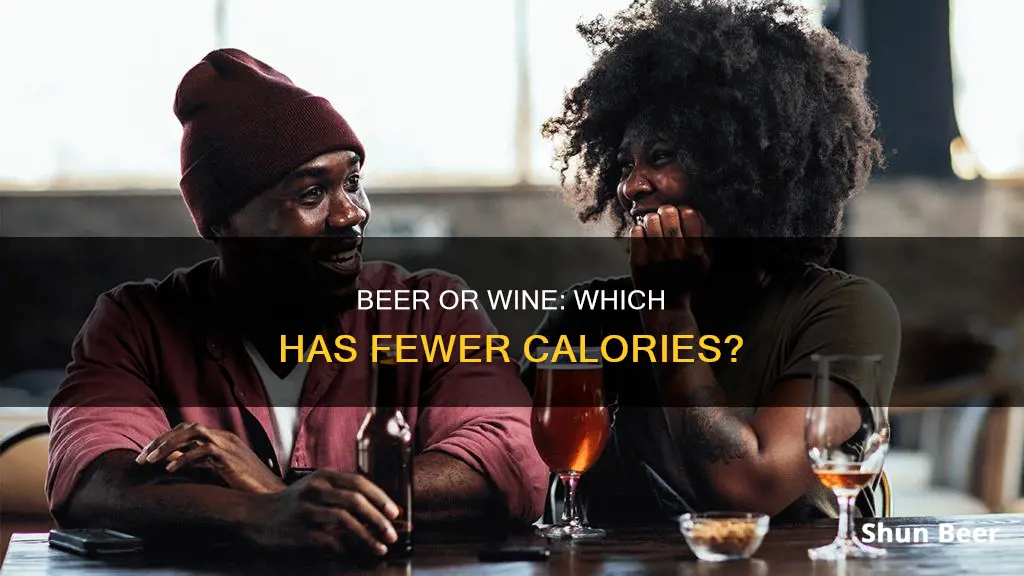
Alcoholic drinks are often loaded with calories, and it's no secret that excessive drinking can lead to weight gain. But when it comes to beer versus wine, which one has fewer calories? Is it the frothy, fermented grain beverage or the fruit of the vine? Well, it's not a simple answer, as it depends on several factors, including the type of beer or wine, the serving size, and the alcohol and sugar content. Let's dive into the details and uncover which drink is the better choice for those watching their waistline.
What You'll Learn

Beer has more calories per serving than wine
When it comes to calories, beer has been found to have more per serving than wine. A standard serving of wine (5oz) contains 118 calories, while a standard serving of beer (12oz) contains 147 calories. This means that a bottle of wine will typically have fewer calories than a bottle of beer.
The calorie difference between beer and wine can be attributed to the leftover carbohydrates found in beer. Beer is made from grains, such as barley, wheat, and rye, which store carbohydrates in the form of starch. During the brewing process, enzymes break down these starch molecules into smaller pieces, with the smallest being converted into alcohol by yeast. However, some larger starch molecules remain, which cannot be broken down by yeast, resulting in leftover carbohydrates that contribute to the overall calorie count of beer.
On the other hand, wine typically has a lower sugar content than beer. The alcohol in wine comes from the fermented sugar in grape juice, and since most of the sugar is converted into alcohol during fermentation, the residual sugar content is generally low.
It is worth noting that the calorie content of beer and wine can vary depending on various factors, such as the type of beer or wine, the alcohol percentage, and the serving size. For example, lighter beers tend to have lower calories than darker beers, and the same is true for white wine compared to red wine. Additionally, the way alcohol is processed by the body is different from how calories from carbohydrates are processed, making the impact of alcohol calories on weight gain less significant.
While the calorie difference between beer and wine exists, it is important to remember that excessive consumption of any alcoholic beverage can hinder weight loss goals. Alcoholic beverages provide "empty calories," meaning they offer little to no nutritional value. Therefore, drinking in moderation is crucial, regardless of the type of alcohol consumed.
Arby's Beer Battered Fish Sandwich: Calorie Breakdown
You may want to see also

Wine has fewer calories from carbohydrates
Lighter beers, such as lagers and pilsners, tend to have a lower carbohydrate content, while darker beers have a higher content. A 425ml serving of beer typically contains 6-18 grams of carbohydrates, translating to 24-72 calories from carbs. In contrast, a 150ml glass of dry red or white wine usually contains only 0.5-2 grams of carbohydrates, providing 2-8 calories from carbs.
The type of wine also affects its calorie content. Rosé wine has around 70-80 calories per 100ml, while white wine has 73-83 calories and red wine contains 75-85 calories per 100ml. Red wine, despite having a slightly higher calorie count, has been associated with various health benefits. It contains antioxidants that benefit heart health, and studies have shown that red wine drinkers have lower amounts of visceral fat around the abdomen.
Additionally, the serving size of beer is typically larger than that of wine. A standard glass of wine is around 150ml, while beer is often served in schooners (425ml) or pints (570ml). Therefore, when comparing equal serving sizes, wine generally has fewer calories from carbohydrates than beer.
However, it is worth noting that the overall calorie content of wine and beer can vary depending on factors such as alcohol percentage and sugar content. While wine has fewer calories from carbohydrates, the total calorie count of a drink depends on various factors, and other low-calorie alcoholic options are available, such as spirits or champagne.
Calories in Corona Familiar: How Much is Too Much?
You may want to see also

Beer is served in larger volumes
When it comes to calories, beer and wine have different considerations. Beer is often served in larger volumes, such as a 12-ounce serving, which is considered a "standard" drink in the United States. On the other hand, a standard serving of wine is typically 5 ounces. This difference in serving size can significantly impact the number of calories consumed.
Beer is typically served in larger volumes than wine, and this has an impact on the overall calorie intake. A 12-ounce serving of regular beer, which is the standard drink size in the United States, contains around 147 calories on average. In contrast, a 5-ounce serving of wine, which is the standard drink size for wine, contains about 118 calories. Therefore, when comparing standard servings, beer has more calories than wine.
The higher calorie content of beer is mainly due to the leftover carbohydrates in the beverage. Beer is made from grain, which stores carbohydrates in the form of starch. During the brewing process, enzymes break down the starch into smaller sugar molecules, and yeast converts the smallest sugar pieces into alcohol. However, some larger carbohydrate pieces remain that the yeast cannot break down, contributing to the overall calorie count.
The type of beer also plays a role in the calorie content. Lighter colour beers tend to have fewer calories than darker beers. This is because lighter beers have a lower alcohol content and a lower ingredient density. For example, a pint of 5% ABV beer contains an estimated 240 calories, while darker beers can have between 100 and 300 calories.
While beer is typically served in larger volumes, it's important to note that the calorie content can vary depending on the specific beer and its ingredients. Additionally, the alcohol by volume (ABV) can also influence the serving size. For instance, a 12% ABV beer may be served in an 8-ounce glass instead of a pint to match the amount of alcohol in a standard drink.
Calorie Count for Busch Light Peach Beer
You may want to see also

Dark beers have more calories than light beers
When it comes to beer, it's a common misconception that dark beers are heavier and more calorie-dense than light beers. However, this assumption is not entirely accurate. While it is true that darker beers are produced using heavily roasted grains, it is the alcohol content, not the colour, that is the primary factor influencing calorie count.
The colour of beer is directly related to the malt content and the roasting process. Light roasted malts result in straw and golden colours, while medium roasts produce amber and copper hues. Darker roasts contribute chocolate and coffee flavours, and the heaviest roasts yield black colours and burnt flavours.
The key factor to consider when comparing dark and light beers is the alcohol by volume (ABV) or alcohol content. In general, beers with higher alcohol content will have more calories. Dark beers, such as stouts, porters, and black lagers, often have an ABV ranging from four to five per cent, which can result in lower alcohol and calorie content compared to lighter-coloured beers. For example, a serving of Guinness (a dark beer) contains 125 calories, while a Bud Light (a light beer) has 110 calories.
It's important to note that the calorie content of beer can vary significantly depending on the type and brand. Lighter-coloured beers tend to have lower alcohol content and ingredient density, resulting in a lower calorie count. However, there are exceptions to this rule, as some light beers can have higher calorie content than their darker counterparts. Therefore, when making a choice based on calorie content, it is advisable to pay attention to the ABV or alcohol content rather than solely relying on the colour of the beer.
Additionally, it is worth mentioning that beer generally has more calories than wine. The calorie difference between the two beverages is mainly due to the leftover carbohydrates in beer, as the sugar content in wine is typically low. However, within the category of beers, the colour is not a reliable indicator of calorie content, and it is essential to consider the ABV or alcohol content for a more accurate comparison.
Calories in Leinenkugel's Cranberry Ginger Beer: A Healthy Treat?
You may want to see also

Red wine has more calories than white wine
When it comes to calories, red wine has more calories than white wine. On average, red wine contains between 75 and 85 calories per 100ml, while white wine has slightly fewer calories, ranging from 73 to 83 calories per 100ml. This difference in calorie content is due to the higher alcohol content typically found in red wine. Wines with higher alcohol content tend to have more calories.
The colour of the grapes used and the winemaking process also contribute to the difference in calorie content between red and white wine. Red wine is made from red grapes that are transferred directly to vats and fermented with the skin, seeds, and stems, which give the wine its colour and provide beneficial plant compounds. White wine, on the other hand, is made by pressing the grapes before fermentation, removing the skins, seeds, and stems, resulting in a lower calorie beverage.
While red wine has more calories, it also offers slightly higher amounts of some vitamins and minerals, such as calcium, vitamin K, and zinc. Additionally, red wine has been linked to potential health benefits, including a reduced risk of heart disease and a slower rate of age-related mental decline. However, excessive consumption of any alcoholic beverage, including red wine, can lead to negative health consequences.
When comparing the calorie content of beer and wine, beer typically has more calories. On average, a pint of 5% ABV beer contains around 240 calories, while a standard 175ml glass of 12% ABV wine has approximately 133 calories. However, it is important to note that the calorie content can vary depending on the type of beer or wine. Lighter-coloured beers tend to have fewer calories than darker beers, and wines with lower ABV percentages generally have lower calorie counts.
Gluten-Free Beer: Calorie Count of Wilde's Offerings
You may want to see also
Frequently asked questions
Wine has fewer calories than beer. A standard glass of 175ml 12% wine contains around 133 calories, while a pint of 5% beer contains around 240 calories.
Yes, red wine tends to have a higher alcohol content, so it usually has more calories than white wine.
A shot of spirits or a glass of champagne is a better option than either beer or wine if you're looking for the lowest-calorie option.
The calorie content of beer and wine is influenced by the alcohol content and the presence of carbohydrates and sugars.
It is recommended to buy lower-calorie beer, stick to single servings of wine, and practise moderation when consuming either beverage.







